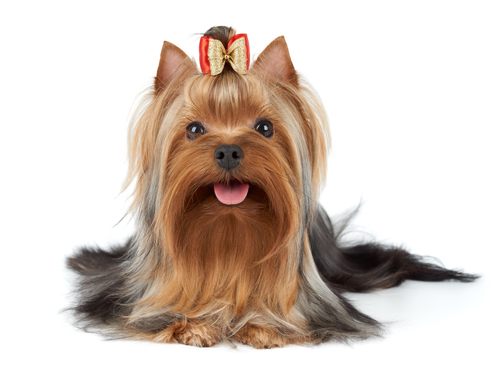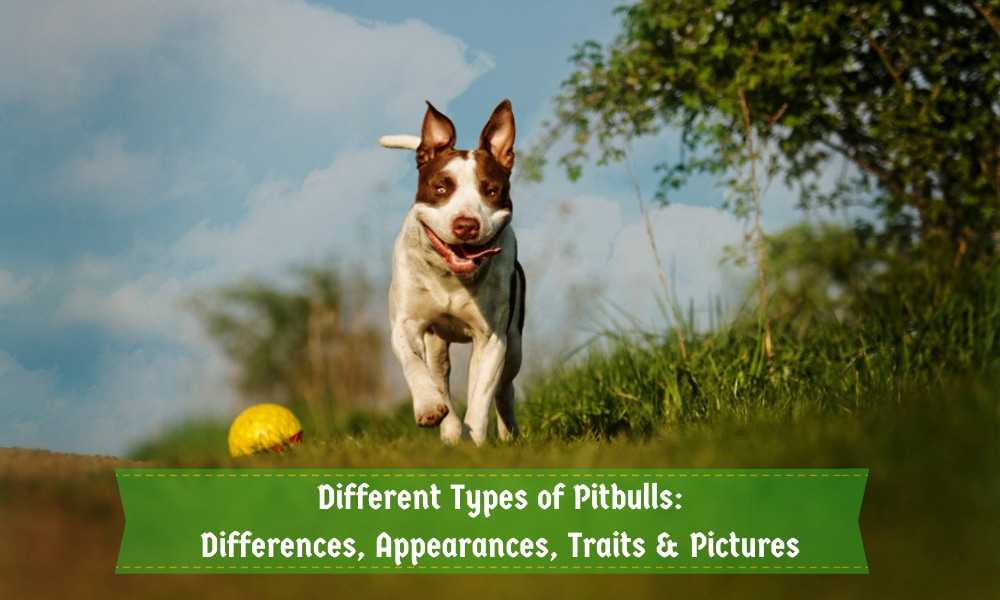
A lot of people don’t realize that pit bulls are not a single specific breed. It’s actually a family of dogs that includes a few different types. To understand where the different types of pitbulls came from, it helps to know the history of the pitbull.
Contents
History
Pit bulls go all the way back to ancient Greece and a dog breed called the molosser. The molosser was a strong, powerful dog breed used for protection and in battle. It had many of the defining characteristics of the pit bull – strong and powerful with a large head and wide jaw. Other powerful breeds share this ancestor, including mastiffs.
The pit bull as we know it was bred in England. It was a mix of a bulldog with various breeds of terrier. Back then, bulldogs weren’t the short, squat dogs we think of today. They were larger, leaner, and more athletic. Breeding these dogs with terriers resulted in a mixed dog breed that is strong, tough, powerful dog used for fighting and sports like bull-baiting, which is where the pit bull got its name. While bull baiting was banned in the early 1800s, this reputation of fighting has unfortunately stayed with pit bulls.
Pit bulls were brought to American in the 1870s where they appealed to farmers who used them as hunting dogs. American breeders valued smaller, faster dogs over larger, more powerful ones so the breed started to change. In the 1930s, the breed split into different types as the dogs were bred to conform to different uses and tastes.
Today, as you’ll see, there are still a variety of pit bulls types out there but they are no longer bred for fighting. Quite the opposite as most have been bred not to show aggression, especially toward humans.
Let’s take a close look at the different types of pit bulls and how to tell the difference between them.
American Pit Bull Terrier
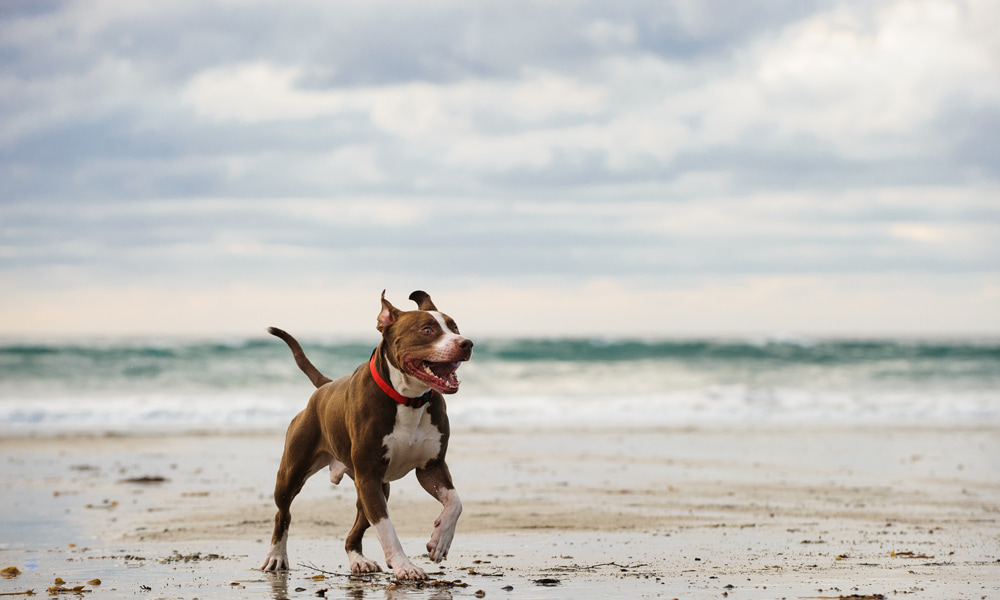
Source: canva.com
The American Pit Bull Terrier is probably what you picture when you think of a pit bull. When the pit bull first arrived in America, its size, strength, and courage made it ideal for hunting wild hogs and driving livestock as well as being a loyal companion.
One of the most notable things about this breed is the head. While it’s proportionate to the rest of the body, it’s broad with a wedge shape and a chiseled, short, well-defined muzzle. The American pitbull has a deep, wide chest and a broad back with well-developed muscles covering the entire body. Their smooth, glossy coat feels a little stiff and comes in a variety of colors and patterns, including blue, red, grey, black and white, and brindle.
Males are about 18 to 21 inches at the shoulder and weigh between 35 and 60 pounds. Females are generally a little smaller, at 17 to 20 inches and between 30 and 50 pounds. Interestingly, it’s recognized as an individual breed by the United Kennel Club but not the American Kennel Club.
The American pit bull makes a great pet for anyone who has the time to give them the attention they need. They can be stubborn and require a lot of training and socialization when they’re young. Because they grow to be so strong as adults, it’s important to get these behaviors under control when they’re young and more manageable.
Pit bull owners should know that this isn’t a dog you can let run free at the dog park. American Pit Bull Terriers should always be leashed when out in public and around other animals. If trained properly, they are not likely to start a fight. That said, they are not afraid and won’t back down if challenged. These dogs love children but are very strong, big, and energetic so should never be left unattended with little ones.
American Staffordshire Terrier
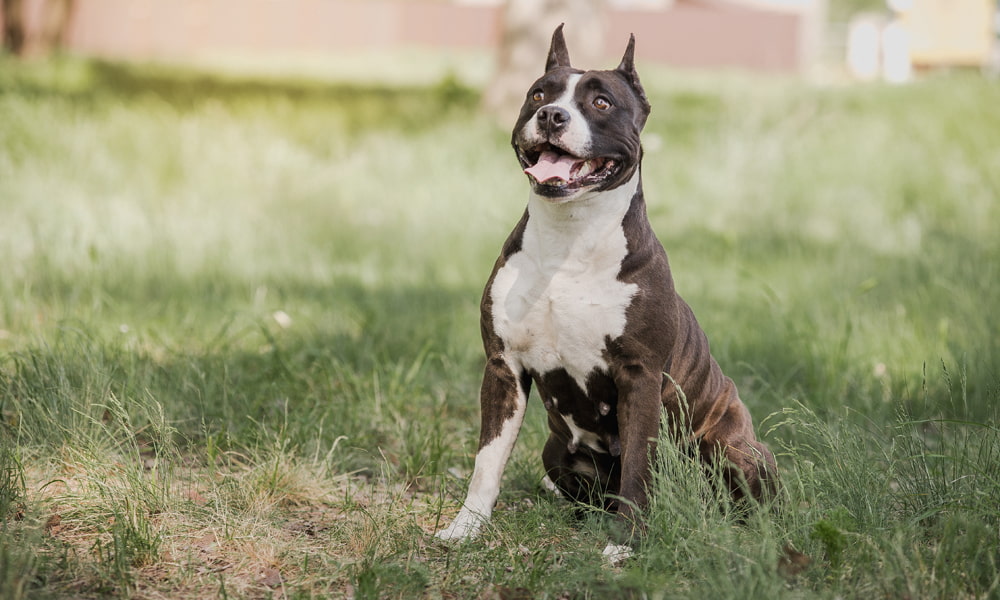
Source: canva.com
The American Staffordshire Terrier is very closely related to the American Pit Bull Terrier. When this dog breed arrived in America, larger dogs were bred by Americans while the Staffordshire Terrier remained truer to the breed’s original size. The American Kennel Club recognized the smaller breed as the American Staffordshire Terrier in 1976. These two breeds are very similar but they have been bred separately for more than 50 years and are two distinct types of pit bull.
American Staffordshire Terriers have short, smooth coats that come in a variety of colors, including black, red, and fawn. They’re stocky but agile with a broad head and high-set ears. Their back is fairly short and they have a wide chest and stance.
Males are about 17 to 19 inches high, females are 16 to 18 inches high. Adult American Staffordshire terriers weigh between 40 and 60 pounds on average. As with the American Pit Bull Terrier, these dogs are strong, confident, and athletic. Early socialization and training are necessary to instill good habits in them before they reach adulthood. They can be confrontational with other dogs if not on a leash.
These dogs are loyal, affectionate, and love to be around people. They make great guard dogs because they are protective of their families but their strong, muscular build and the breed’s history give them a bad reputation. That said, they are big and like to play rough so children should never be left with them unsupervised.
Staffordshire Bull Terrier
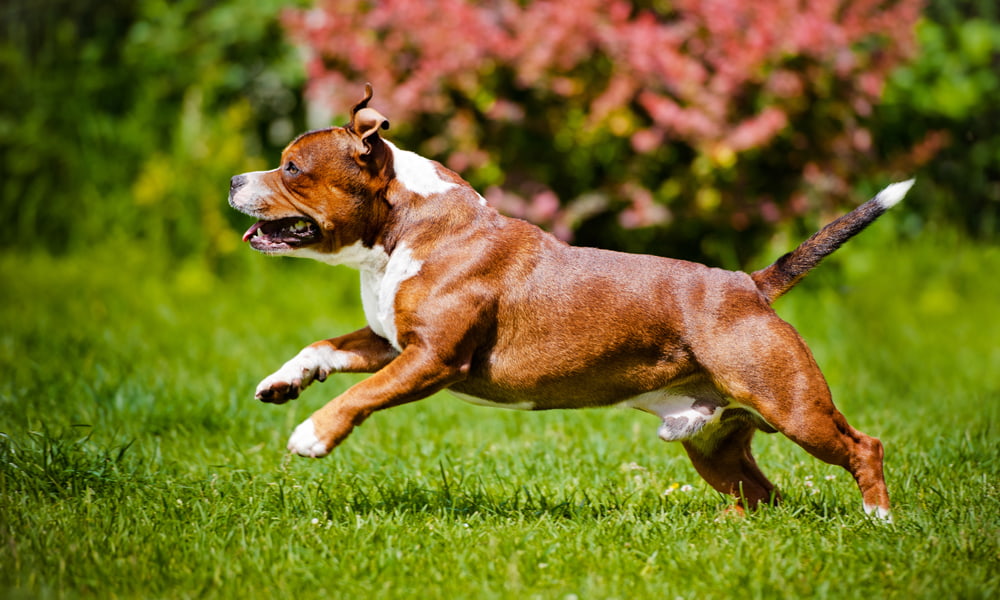
Source: canva.com
The Staffordshire Bull Terrier shares the same ancestors as other pit bull breeds but it was bred to be smaller and faster in the fighting ring as well as gentle and loving toward people. It’s believed this dog was the result of breeding a bulldog with an early version of the Manchester Terrier. It has been recognized as a separate breed identification since the 1830s.
One thing’s for sure, this dog looks imposing. Though it’s slightly smaller than other pit bulls, it’s often recognized as the most muscular type. It has a shorter muzzle than other pit bulls and tends to be very vocal. The Staffordshire Bull Terrier has a smooth, short coat that comes in brindle, white, black, blue, fawn, or red. They stand only 14 to 16 inches high with males being on the high end and weighing between 28 and 38 pounds. Females weigh between 24 to 34 pounds.
This pitiful breed has a playful temperament and a lot of energy. This breed of pitiful owners note that they love being around people and do not do well when left alone for long periods of time. One of their nicknames is “the nanny dog” so their love of children is pretty apparent. That said, a dog owner should never let children be left unattended with a Staffordshire Bull Terrier.
As with all pit bull types, the Staffordshire Bull Terrier benefits from early socialization and training and needs a lot of attention to maintain good behavior. They need daily exercise and a large fenced-in yard is ideal. Note that this breed also really likes to dig. Underground electric fences are not a good choice and any physical fence should be reinforced at the bottom to prevent the dog from digging under it.
Bull Terrier
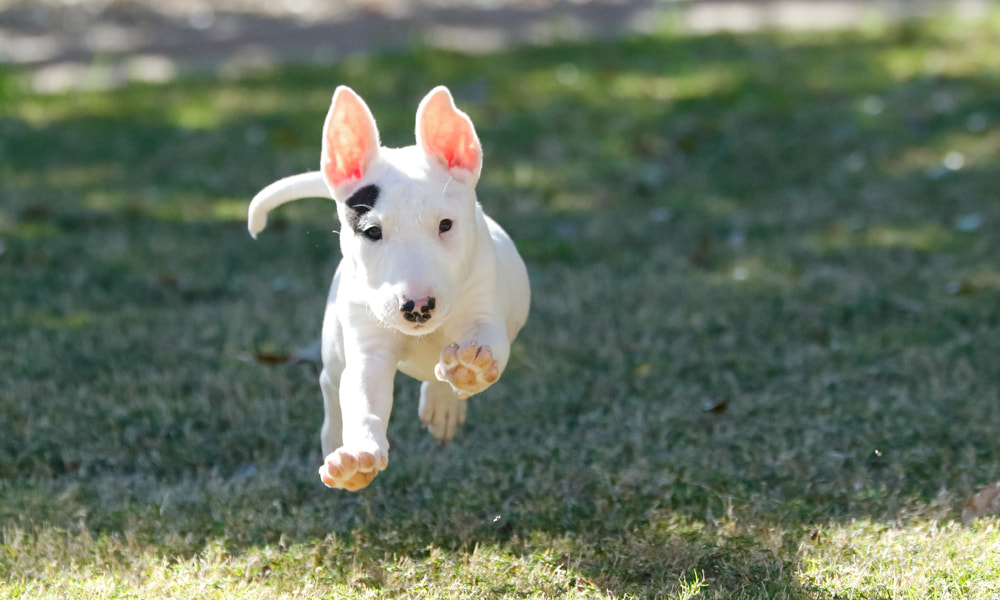
Source: canva.com
One of the most unique types of pitbull type dogs is the Bull Terrier. They’re believed to be a mix of a bulldog with a now-extinct breed, the white English Terrier, that was later bred with Spanish Pointers to make them a little bigger. These dogs are strong, tough, and courageous with a sweet disposition.
This dog definitely has a unique look. Its long, slightly egg-shaped head and muzzle are its most recognizable characteristics. They have dark, sunken eyes and small, thin ears that are close together. Bull Terriers come in white and white with colored markings. Their short, flat coat is hard to the touch with a shiny appearance. They’re easy to groom and shed twice a year.
Their broad chest and well-rounded body are strong and muscular without appearing heavy. They’re solidly built without any bulk but Bull Terriers are still pretty hefty dogs. They stand about 21 to 22 inches high and vary in size. Males weigh between 55 and 65 pounds while females are between 45 and 55 pounds. That said, they can be as light as 35 pounds or as large as 75 pounds.
These dogs don’t like being by themselves and can get destructive when they’re bored. Early training is essential and good behavior has to be strictly reinforced throughout the dog’s life. Bull Terriers are busybodies, intelligent, and independent which are qualities that are sometimes difficult to work around in a dog. They’re a good fit for an active, energetic family with experience caring for and training dogs.
Because they’re so active and are known to play rough, Bull Terriers are not meant for homes with small children. They’re aggressive toward dogs of the same gender but are usually tolerant of the opposite sex. That said, they don’t do well in a home with other pets, including cats and other small furry animals. They see them as prey and can get aggressive.
There is also a Miniature Bull Terrier breed that has all of the same attributes and traits but on a smaller scale. These dogs measure only about 10 to 14 inches at the shoulder and weigh between 25 and 33 pounds.
Other Types of Pit Bulls
Here are some different types of pitbulls that you might come across if you’re looking to buy or adopt one and are doing your research.
Colby Pit Bull
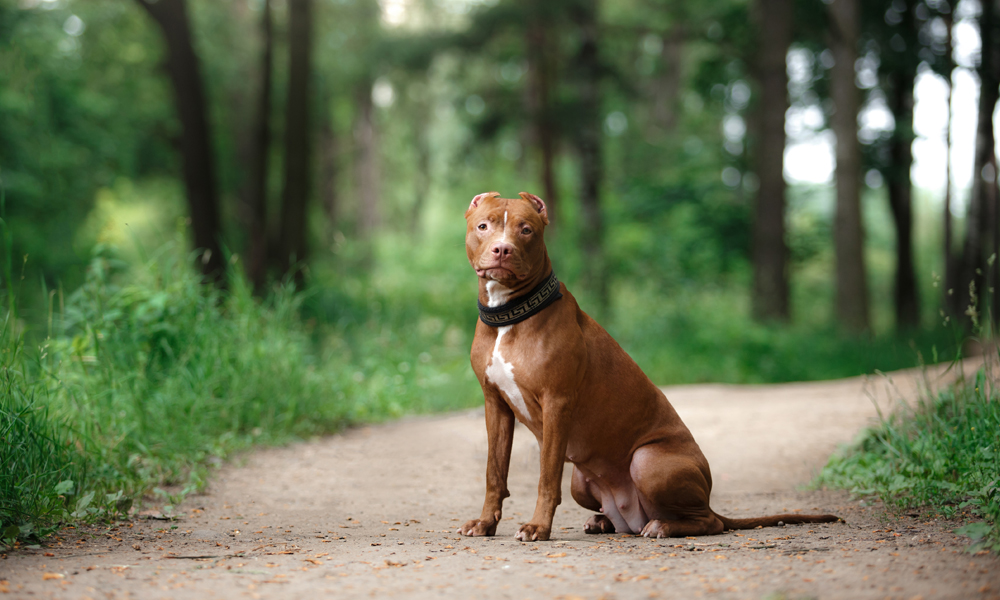
Source: canva.com
John P. Colby fell in love with pit bulls back in 1888. He began breeding them in the US using dogs with a lineage that could be traced back to England and Ireland. His son, Louis, inherited this love of pit bulls and continued breeding them to establish the Colby bloodline. The Colby Pit Bull is believed to be the oldest and purest of modern pit bulls. While a lot of pit bulls today have some Colby blood in them, one that is pure Colby is a rare find.
Like all pit bulls, the Colby is a strong, muscular dog. It has more bulk than some of the other types and a broad, strong head with a wrinkled, flat snout. These dogs are generally a little smaller than what you might expect, between 17 to 19 inches high at the shoulder.
Chamuco
The Chamuco is sometimes referred to as the Mexican Pit Bull. It’s a somewhat rare breed of dog that resulted from crossbreeding between American Pit Bulls, Staffordshire Bull Terriers, the now-extinct Mexican Bulldog, and others. Their small, high-set ears are one of their most recognizable features.
This pit bull type dog was developed in the 1970s and got its name from the Mexican word for “devil”, which tells you a bit about its personality. It’s strong, tenacious, and intense, like most pit bulls, but is also loving and playful with its family. It needs a competent, strong trainer to keep it inline. It was originally bred for fighting and only kept as a household pet in certain parts of Mexico.
Red Nose vs Blue Nose
One thing about different types of pitbulls that you’ll see a lot is a red nose and a blue nose. The physical differences are obvious – red nose pit bulls have a reddish or pink nose and a coat that is more brown, red, or auburn. Blue nosed pit bulls have a grayish or dark gray nose with a similarly colored coat. Each of these traits is the result of a recessive gene.
These traits don’t necessarily cause any additional health complications, though blue-nosed pit bulls may have sensitive skin and a higher chance of vision and hearing problems.
Red noses are more popular than blue noses and, therefore, usually a little more expensive. It’s always important to check the lineage of your dog and use a reputable breeder to make sure they’re not selecting dogs only to get a certain look. The overall health of the dog is more important, especially with a pit bull. These pups are a happy and loving addition to the right home.
Source of Featured Image: canva.com
I grew up in a household that was filled with animals. I believe that my fate as a dog-loving person was sealed in early childhood since my parents owned several dogs of varying sizes and breeds. There was no choice but to take care of and learn about dog habits and the best animal care practices — otherwise, I’d be clueless about how to go about the creatures I was surrounded by day and night.
As a life-long puppy lover, I know a thing or two about dogs and how to go about caring for them in the best way possible. Although I’m not a professionally trained dog behaviorist, trainer, or veterinarian, all of my knowledge and experience with canines comes from a place of love and a deep-rooted passion for dogs and animals in general.
Seeing as dogs kept me company throughout every stage of my life, I decided to follow a different path in my academic life and obtained a Bachelor’s and Master’s degrees in Marketing Management and Digital Advertising, which ultimately allowed me to combine my professional training and personal experience by creating the ultimate dog lover’s resource website! Along with my husband, Dave, I run MySweetPuppy for like-minded dog lovers who want to have a single, clear, and reliable information source about anything and everything related to dogs and their well-being.

